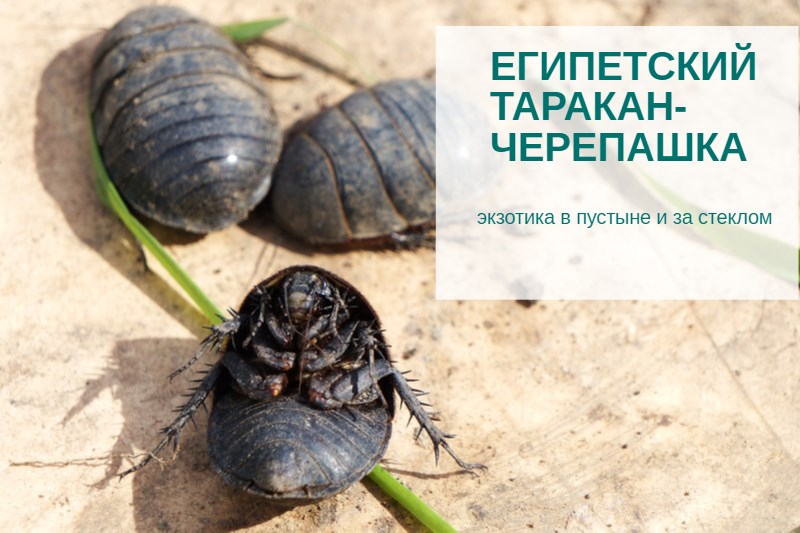Egyptian cockroach: exotic behind the glass of the terrarium
Cockroaches are one of the most unpleasant neighbors in human habitation. They spoil food and household items, carry diseases. The Egyptian cockroach settles in buildings for animals, rarely creeps into houses. It infects food with bacterial and viral diseases. An insect bite damages human skin. For lovers of exotic, the unpleasant qualities of a cockroach are not an obstacle to breeding. Insects are kept in captivity in special terrariums.

Classification
The Egyptian cockroach Polyphaga aegyptiaca refers to insects with incomplete conversion. During the life cycle, it goes through 3 phases in succession: egg, larva, imago. This is a representative of the order Cockroach, family Corydiidae or cockroach-turtle, genus Polyphaga.
Appearance and habitat
Polyphaga aegyptiaca has a pronounced sexual dimorphism. The males are oval, flat, body length 25 mm. Coloring is dark brown or reddish-brown. There are long wrinkled elytra and wings. The head is covered by a large triangular shield of the pronotum. The mouth apparatus is gnawing, directed downward. Antennae long, multi-segmented, bristle-shaped. They are an organ of smell.
Facet eyes are located on the sides of the head. Anterior margin of elytra with small tubercle. Wings and legs are located on the chest. The abdomen ends with a genital plate. Males fly in search of a mating partner, often use wings for planning.
Females are massive, their length is 40-45 mm, width 25 mm. The body is round, convex. The color is brown. The elongated abdomen consists of 8-10 segments, ends with segmented cerci. Insects of both sexes are agile, run fast. They have well-developed muscle tissue. Legs of a traveling type, the special structure of the forelimbs allows you to quickly dig into the ground. The tibia is shortened, the tarsus is well developed, carries 9 spines. Long hind legs help the insect roll over after falling onto its back. The color of the limbs is dark brown.
Information. The Egyptian bug cockroach got its name due to the appearance of the females. They are wingless and resemble small land turtles.
Habitat
The heat-loving turtle-cockroach is found in Central Asia, North Africa, the Mediterranean, the Crimea and the Caucasus. He prefers dry sand and clay biotopes, settles in the burrows of rodents. The synanthropic species often lives in rooms where livestock is kept, creeping in people's homes.
Lifestyle
Representatives of cockroaches are nocturnal. From daylight burrows in sandy and clay soil, rodent burrows. In order to mask, insects freeze in the ground without movement. In case of danger, odorous substances are released. Larvae and adults feed on dry leaves and parts of plants. A significant part of the diet consists of old feces of insects and people.
Relationship with man
Insects do not pose a direct threat to people. They do not eat food. The danger lies in the transfer of helminth eggs, pathogenic bacteria and viruses from rodent and animal feces. Once in the house, cockroaches infect food, in the buildings for animals feed.With a significant increase in the number of insects, chemical processing of the premises is carried out.
Reproduction and development of offspring
Mating of insects occurs at night. Partners look for each other by the smell of pheromones. Fertilized females lay their eggs in special capsules of the ootheca. The masonry is arranged in two rows, the number of eggs is 14-18 pieces. Their size is about 0.5 mm. Offspring are called larvae or nymphs. It appears soft, without chitinous cover. Within a few hours, the larvae darken. Outwardly, they resemble a miniature copy of an imago without wings.
Information. The incubation period in adverse conditions stretches for several months.
The period of change from a nymph to an adult takes about 2 years. During this time, the larva molts 4 times, shedding a tight cover. The offspring lives with their parents, eats the same food. Nymphs are active and mobile, they need speed to survive. The life expectancy of Egyptian cockroaches is 4 years. During this time, the female manages to make 5-6 clutches.
Captivity
Representatives of the species Polyphaga aegyptiaca are easy to maintain at home. They are unpretentious, can become companions of a tortoise or lizard. Insects eat dried reptile droppings. The main diet consists of dry vegetables and fruits - apples, carrots, pumpkin. The pet’s home will be a plastic container or a glass aquarium. The size of the cage depends on the number of individuals. Insects need ventilation. It is necessary to drill holes of small diameter in the walls of the structure.
Information. Egyptian cockroaches, unlike most relatives, do not show interest in the walls of the dwelling and do not try to get out of it. Owners will not have to lubricate the top of the container with petroleum jelly.
As a substrate, experts recommend pouring a mixture of sand and peat. The addition of horse or cow dung is useful, but such products provoke an unpleasant odor. Pets need a drinker in which, along with water, is a piece of cotton wool. This will protect against the drowning of small nymphs. You can decorate the space to your liking, using flat stones, tree bark. An Egyptian cockroach is accustomed to a dry desert climate; it does not need regular maintenance of humidity. Females are more interesting for keeping, they are 2 times larger than males, have an original appearance. For breeding you will need a couple of insects.
The Egyptian cockroach leads a secretive lifestyle, the opportunity to watch it in the terrarium falls in the dark. For most people, this is an exotic representative of the fauna. It is not dangerous, therefore, insects can be grown without special knowledge and experience.

